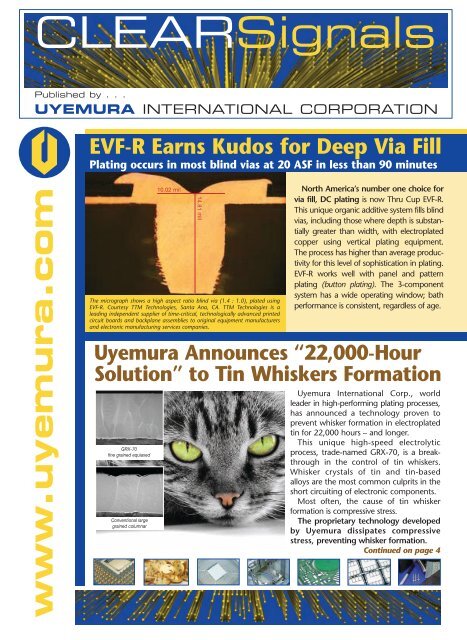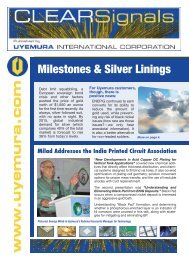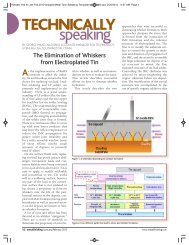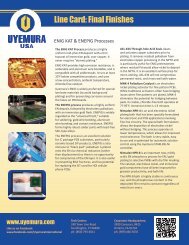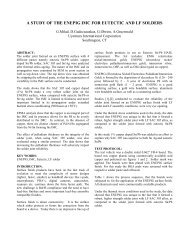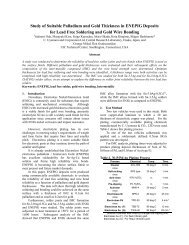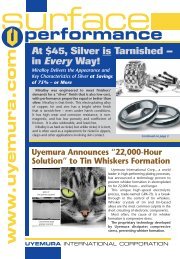Uyemura PCB Newsletter - Uyemura International Corp.
Uyemura PCB Newsletter - Uyemura International Corp.
Uyemura PCB Newsletter - Uyemura International Corp.
Create successful ePaper yourself
Turn your PDF publications into a flip-book with our unique Google optimized e-Paper software.
CLEARSignals<br />
Published by . . .<br />
UYEMURA INTERNATIONAL CORPORATION<br />
EVF-R Earns Kudos for Deep Via Fill<br />
Plating occurs in most blind vias at 20 ASF in less than 90 minutes<br />
www.uyemura.com<br />
The micrograph shows a high aspect ratio blind via (1.4 : 1.0), plated using<br />
EVF-R. Courtesy TTM Technologies, Santa Ana, CA. TTM Technologies is a<br />
leading independent supplier of time-critical, technologically advanced printed<br />
circuit boards and backplane assemblies to original equipment manufacturers<br />
and electronic manufacturing services companies.<br />
North America’s number one choice for<br />
via fill, DC plating is now Thru Cup EVF-R.<br />
This unique organic additive system fills blind<br />
vias, including those where depth is substantially<br />
greater than width, with electroplated<br />
copper using vertical plating equipment.<br />
The process has higher than average productivity<br />
for this level of sophistication in plating.<br />
EVF-R works well with panel and pattern<br />
plating (button plating). The 3-component<br />
system has a wide operating window; bath<br />
performance is consistent, regardless of age.<br />
<strong>Uyemura</strong> Announces “22,000-Hour<br />
Solution” to Tin Whiskers Formation<br />
GRX-70<br />
fine grained equiaxed<br />
Conventional large<br />
grained columnar<br />
10.02 mil<br />
14.81 mil<br />
<strong>Uyemura</strong> <strong>International</strong> <strong>Corp</strong>., world<br />
leader in high-performing plating processes,<br />
has announced a technology proven to<br />
prevent whisker formation in electroplated<br />
tin for 22,000 hours – and longer.<br />
This unique high-speed electrolytic<br />
process, trade-named GRX-70, is a breakthrough<br />
in the control of tin whiskers.<br />
Whisker crystals of tin and tin-based<br />
alloys are the most common culprits in the<br />
short circuiting of electronic components.<br />
Most often, the cause of tin whisker<br />
formation is compressive stress.<br />
The proprietary technology developed<br />
by <strong>Uyemura</strong> dissipates compressive<br />
stress, preventing whisker formation.<br />
Continued on page 4
EDITORIAL<br />
“Precious Metals – Still on the Rise”<br />
By Don Walsh, Director of Operations<br />
“UYEMURA<br />
BATHS<br />
CAN<br />
REDUCE<br />
GOLD<br />
CONTENT<br />
BY HALF”<br />
Our last few editorials<br />
forecasted a continuing rise<br />
in precious metals, which<br />
has, indeed, occurred. Can they<br />
keep rising? And if so, how can<br />
buyers manage what seems to be an<br />
endless climb?<br />
For our general metal finishing<br />
customers, an effective strategy has<br />
been a switch from silver to<br />
Miralloy. The latter does not tarnish<br />
and costs 80% less than silver plating.<br />
Not bad.<br />
Equally substantial savings can be<br />
realized by our ENIG customers in the<br />
electronics industries.<br />
At these $1300+ price ranges for<br />
gold, 80% of the cost of running<br />
ENIG is due to the amount of gold on<br />
the boards. And <strong>Uyemura</strong> baths can<br />
reduce that gold by half. We have<br />
developed several baths with a proven<br />
track record in this regard, and they<br />
have been operational now for several<br />
years. As a result, several <strong>Uyemura</strong><br />
customers are enjoying a 50% savings<br />
on their ENIG running costs.<br />
Surprisingly, the one sector that has<br />
cut back substantially on gold use is<br />
the industry that uses it the most,<br />
jewelry manufacturing. Since 2005,<br />
use has plummeted more than 35%,<br />
according to an article in the<br />
Wall Street Journal on 11/18/10.<br />
Savvy manufacturers are using much<br />
more silver, as well as platinum.<br />
(Silver is cheaper, but platinum is<br />
more expensive than gold, so it is<br />
chosen for style reasons, as opposed<br />
to cost savings.) Also, many wedding<br />
bands are now made with cobalt and<br />
tungsten. This industry still uses 52%<br />
of world-wide gold purchases, but<br />
that is down from 73% in 2005.<br />
As to the current wisdom regarding<br />
where gold, silver, and the other precious<br />
metals are headed, there is more<br />
confusion than clarity. As always,<br />
anyone who could make predictions<br />
with certainty would be making<br />
millions instead of writing about it.<br />
An astute article in the November<br />
10, 2010 New York Times pointed out<br />
that all the reporting on record-high<br />
gold prices is far from accurate if<br />
adjusted for inflation. The former<br />
record, set in 1980, would equate to<br />
$2387 per ounce today – so the metal<br />
will have to move 68% higher if it is to<br />
set a true “record.”<br />
In late 2010, Ryan Chittum from the<br />
Columbia Journalism Review suggested<br />
that the epidemic of gold records is<br />
largely perpetrated by journalists who<br />
are less than fully informed about<br />
economics – or history. An easy, “hot”<br />
story is, for many of them, far sexier<br />
than the truth. He urged the news<br />
media to stop misleading its readers.<br />
In recent weeks, gold pushed<br />
through $1400 and silver topped<br />
$33, although both have retreated –<br />
for now. Where they will be by the<br />
time you read this, no one knows. As<br />
always, buy smart and use wisely.
MORE ON ACID COPPER<br />
Superior plating results for challenging parts with<br />
high aspect ratio holes and uneven circuit density distribution<br />
have made Thru Cup EPL the leading product in its<br />
class. The system is easy to manage and uses DC current (5-<br />
25 ASF). Equally important, it performs without the need<br />
for pulse rectification. This makes plating chemistry easier<br />
to control, and eliminates a costly and often problematical<br />
piece of equipment.<br />
For faster plating, an excellent DC bath alternative is<br />
Thru Cup ETN (20-40 ASF). ETN is an acid copper additive<br />
specifically for printed wiring boards. It is ideally suited for<br />
vertical conveyorized lines, where process speed is crucial.<br />
ETN was engineered for current densities as high as 40 ASF<br />
or 4.0 ASD. It combines the simplicity of DC plating, with<br />
results that rival more complex waveforms of pulse plating.<br />
The chemistry of ETN is highly stable and does not<br />
need continuous regeneration.<br />
The Thru Cup ETN process produces a fine-grained<br />
equiaxed copper deposit. Its leveling capability<br />
overcomes irregularities on the substrate surface and<br />
prevents nodule growth. The deposit is bright and<br />
ductile, with excellent elongation, tensile strength<br />
and metallurgical properties.<br />
Thru Cup ETN is a two-component system: the<br />
carrier controls deposit uniformity, and the brightener<br />
is the grain-refining additive. Solution components and<br />
additives have a wide operating window.<br />
Watch for new developments regarding a system<br />
that will fill the via and simultaneously plate the<br />
through-hole, using insoluble anodes.<br />
ENIG/ENEPIG<br />
UPDATE<br />
ENIG is fast becoming the first choice for LF soldering,<br />
despite the meteoric rise in gold prices. A new generation of<br />
ENIG is already in place to mitigate nickel corrosion. This<br />
new generation technology has been successfully implemented<br />
at prominent manufacturing sites worldwide.<br />
Interest in ENEPIG continues at a record pace,<br />
thanks to its excellent performance as an LF soldering<br />
surface, gold and aluminum wire bondable<br />
surface, and contacting surface. <strong>Uyemura</strong> ENEPIG<br />
protects the electroless nickel interface using a thin<br />
electroless palladium layer, prior to immersion gold,<br />
preventing gold attack on the EN surface. Plus,<br />
<strong>Uyemura</strong> ENEPIG is black-nickel free.<br />
IPC is currently writing a much-needed specification<br />
for the industry.<br />
(See story, page 4)<br />
. . . More than Immersion Tin . . . More than Immersion Silver<br />
<strong>Uyemura</strong> ENEPIG<br />
Provides a Final Finish that is<br />
Close to “Indestructible”
GRX-70: 22,000-Hour Solution . . .<br />
Continued from Page 1<br />
GRX-70 uses a high purity anode, and is ideally<br />
suited for connectors and semiconductor lead<br />
frames. It offers high deposition speeds for rackless<br />
and reel-to-reel processing, and high deposition<br />
efficiency over a wide current density range. The bath<br />
is lead and fluoride free, and foam-resistant.<br />
Operating range is 113-131°F, with 122° the optimum.<br />
The GRX-70 film has a uniform white matt<br />
appearance; appearance after reflow is excellent.<br />
Carbon and sulfur concentrations in the film are very<br />
low, and control over liquid level is easy. The film is<br />
heat-resistant, with excellent solderability.<br />
For detailed product data or test information,<br />
contact your <strong>Uyemura</strong> representative.<br />
John Nowakowski is New Technical<br />
Salesperson for the Southeast and<br />
Mid-Atlantic States<br />
John is an experienced “generalist”<br />
with several valuable specialties.<br />
He has extensive experience with<br />
connector plating and general metal<br />
finishing, and has worked for two<br />
continuous plating businesses, also<br />
for a full-line distributor and two proprietary plating<br />
process manufacturers.<br />
His strong background in the connector and general<br />
metal finishing arenas, combined with UIC’s fastgrowing<br />
product acceptance, will provide many<br />
additional customers the benefit of state-of-the-art,<br />
yield-improving processes.<br />
ACL-634 is a New ENIG<br />
Through-hole Cleaner<br />
This acid-type soaking cleaner is well suited for<br />
the pretreatment in electroless Ni/Au processes<br />
with NPT (Non-Plating Through-hole). ACL-634<br />
removes palladium from NPTH, will not damage<br />
permanent resist, and rinses well with water.<br />
IPC Plating Committee 4-14<br />
ENEPIG Specification Update<br />
Objective: To determine the thickness of Pd in<br />
ENEPIG for soldering and wire bonding applications.<br />
The following suppliers provided the required<br />
finish for the Round Robin Testing: Atotech, Dow,<br />
<strong>Uyemura</strong>, Cookson, OMG and MacDermid<br />
Solderability and Solder Joint<br />
Reliability Testing<br />
“Wetting Balance” and “Spread Tests” were<br />
performed following temperature and humidity<br />
stressing. Solder joint reliability was tested by ball<br />
shear. All testing was run with tin/lead and<br />
SAC305 LF solder.<br />
The W coupon (IPC-6012) was used.<br />
The thickness of the ENEPIG tested was as follows:<br />
• EN: 5 µm +/- 1<br />
• EP: 0.1, 0.2, 0.3, and 0.5* µm<br />
(* only from one supplier).<br />
• IG: as much as supplier immersion gold<br />
process will allow.<br />
Status: Wetting Balance and Solder Spread testing is<br />
now complete, and results are being tabulated.<br />
Wire Bonding:<br />
The Wire Bonding Coupon supplied by K&S:<br />
There are 2 levels of surface roughness. One was<br />
particularly coarse (RA~100), using mechanical<br />
scrubbing. The thickness to be tested was as<br />
described above.<br />
All combinations were tested as follows:<br />
• Gold wire bonding ball/wedge<br />
• Samples will be bonded as received and<br />
after stress (4 hours at 150°C)<br />
Status: Coupons are at the testing sites, with results<br />
expected by the end of March, 2011.<br />
This IPC Committee is co-chaired by<br />
George Milad and Gerard Obrien.<br />
UYEMURA INTERNATIONAL CORPORATION<br />
<strong>Corp</strong> HQ: 3990 Concours, #425 • Ontario, CA 91764 • ph: 909.466.5635<br />
Tech Center: 240 Town Line Road • Southington, CT 06489 • ph: 860.793.4011<br />
www.uyemura.com


